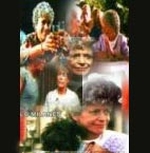 “Nuestro objetivo final es nada menos que lograr la integración del cine latinoamericano.
Así de simple, y así de desmesurado”.
“Nuestro objetivo final es nada menos que lograr la integración del cine latinoamericano.
Así de simple, y así de desmesurado”.
Gabriel García Márquez
Presidente (1927-2014)


-

Reyna y rey: Canon y desenlace en los noventaPor Amarilis Terga OlivaAunque la crítica especializada se empeña en enunciar cierto desfasaje entre originalidad (asumida como provocación) y sutilezas (como argucias o códigos estéticos y semánticos) propios del discurso cinematográfico de los noventa, el filme Reyna y Rey realizado por Julio García Espinosa en 1994 merece atención aparte ya que se encuentra entre las películas emblemáticas del período, a pesar de sus limitaciones.
Reyna y Rey no inaugura el cáustico y prolijo lustro, pero contribuyó a otorgarle madurez en el contexto creativo iniciado por Orlando Rojas con Papeles secundarios, de 1989, y Daniel Díaz Torres con Alicia en el pueblo de maravillas, de 1990. La película fue coproducida por el ICAIC con escasísimos recursos y TeleMadrid S.A. con idea y guión de su realizador, la dirección de arte de Pedro García Espinosa y la fotografía de Ángel Alderete.
Dedicada al reconocido cineasta Cesare Zavattini, la obra da fe del tratamiento de un tema profundamente humano con alcance universal que posee actualidad y relevancia en todos los tiempos: la soledad espiritual de una mujer frecuentada desde la perspectiva de la ancianidad. Reyna vive con su mascota en la mansión donde fue empleada otrora, espacio que comparte con Rey, su perro, como asidero donde se canalizan sus sentimientos. Las actuaciones de Consuelo Vidal, Coralia Veloz Fernández y Rogelio Blaín entre otras, muestran coherencia y prestancia interpretativa con respecto a los sintagmas que propone el argumento y discurso cinematográfico.
Emilio y Carmen regresan de Miami cuando se recrudece la crisis en Cuba, contexto en el que Reyna se ve obligada a entregar su mascota a la perrera debido a la aguda situación económica. Durante el reencuentro tienen lugar las subtramas reveladoras de zonas socio-espirituales que atañen al autorreconocimiento de la patria como memoria y espacio donde se expresa la gama de sentimientos íntimos y elevados.
El tratamiento de la patria por el personaje de Carmen enlazado desde el punto de vista semántico a la trama principal revela matices y reflexiones a través de los parlamentos que le conciernen. Este tópico dialoga con criterios diversos dados mediante otros personajes que no llegan a convertirse en tipos sociales como: la amiga de Carmen y la presidenta del CDR. El regreso a Cuba para Carmen es no sólo volver a casa (espacio vital de empatías y recuerdos), es un viaje que no termina con la visita a Tropicana, pues precisa de la revisión de su existencia marcada por las palmas, cual símbolo que estigmatiza su reencuentro con recuerdos, sabores y olores retomados como norma del vivir.
La búsqueda de la felicidad es un tópico tratado en la obra que deviene en la materialización de afectos y sentimientos proclives al disfrute de la fantasía y el despliegue de emociones. Nudos de conflictos subyacen y nos acercan a la problemática socio-espiritual de esos tiempos tales como: cambios sociales que afectaron modos y estilos de vida en la sociedad cubana de entonces, desarraigo, ruptura con afectos y sentimientos, así como la necesidad de realización humana que cede espacio a la prostitución y desaliento.
El exilio como vía posible para resolver la existencia humana es apuntado con naturalidad, apreciándose una intención ajena a todo nihilismo, razón por la cual se convierte en sutileza semántica que defiende la condición humana y social del hombre.
De modo que todo el acontecer contextual se expresa como factor en derredor del cual tiene lugar la historia matizada por sus disímiles condicionantes. A penas se muestra la crudeza de un lustro de profunda crisis económica y social que desplazó valores y afectó de manera cáustica zonas de nuestra identidad colectiva que merecen un análisis más exhaustivo, pues el argumento se desarrolla si bien no al margen de la realidad, centra su interés en asuntos humanos por resolver.
En tal sentido, la decisión de optar por la soledad por parte de Reyna y Rey transciende los nexos afectivos e íntimos que provoca sufrimiento en ambos y se convierte en parábola que refleja la problemática real de nuestra nación en un período tan convulso de la historia. La nulidad no encuentra cabida en la trama que termina con el llanto de Reyna como final abierto o improbable desenlace al que nos convoca el filme.
Del discurso cinematográfico merece especial atención la dinámica que muestran los planos medios, generales y paneos, que responden a la calidad estética de la fotografía caracterizada por el naturalismo de entornos y espacios interiores, en cuyo ámbito se expresan gradaciones tonales en correspondencia con la situación dramática que narra la historia en tiempo y espacio definidos.
Sobre el lugar que ocupa el filme dentro de la cinematografía de los noventa, el crítico Juan Antonio García Borrero ha expresado que Reyna y Rey contribuye a determinar o enfatizar la tendencia más activa en la década para el cine cubano1 , aunque se limita a narrar una historia que no sobrepasa los límites impuestos por una pararrealidad que no alcanza a convertirse en propuesta inteligente, pues la linealidad cinematográfica enfocada por el argumento se basa en fórmulas tradicionales, lo cual se revela a través de la sujeción a códigos y normas que inscriben el filme como deudor de la herencia estética y cultural que caracteriza al cine cubano. A tono con las particularidades que asume la cinematografía del período, Orlando Rojas refiere: “Es la nada: crear sobre una falsa poética. Excepto tres o cuatro buenas películas, no existe ni suficiente realidad ni suficiente poesía. Es un cine que creo no va a ninguna parte pues no crea una realidad nueva a través del arte ni es capaz de poetizar lo cotidiano aunque sea desde el punto de vista íntimo”.
De manera general se aprecia que Reyna y Rey ocupa un lugar de relevancia dentro de la historia cinematográfica de los noventa, a pesar de sus imponderables es portadora de lo más preciado de nuestro haber: la necesidad de salvarnos como nación con el reconocimiento profundo de nuestros valores contenidos en la identidad y espiritualidad colectiva, de manera que su guionista y realizador Julio García Espinosa ha tratado la soledad de una anciana como asunto que se convierte en correlato para representar el panorama superestructural de la sociedad cubana en el primer lustro de los noventa, dando fe de que no es posible el desenlace, porque el dolor es también un signo de madurez a pesar del lloro y la nostalgia.
BIBLIOGRAFÍA:
-Caballero, Rufo: Aquí el problema es no morirse, C. de La Habana, Editorial Pinos Nuevos.
-Apreciación cinematográfica (Manual de estudio), C. de La Habana, Ministerio de Educación: Tomos I y II.
-García Espinosa, Julio: “El cine cubano o los caminos de la modernidad” en Temas, C. de La Habana, No. 27, octubre-diciembre de 2001: pp. 28 - 36.
-García Borrero, Juan Antonio: “La utopía confiscada. De la gravedad del sueño a la ligereza del realismo”. Ibid: pp. 17-27. Reyna y Rey: Canon and denouement in the 1990s
Reyna y Rey: Canon and denouement in the 1990s
By Amarilis Terga Oliva
Although the specialized critic is determined to enunciate a certain disparity between originality (assumed as provocation) and subtleties (as chicaneries or aesthetic and semantic codes) characteristic of the film discourse of the 1990s, the film Reyna y Rey made by Julio García Espinosa in 1994 deserves a separate attention since it is among the emblematic films of the period, in spite of its imitations.
Reyna y Rey does not inaugurate the caustic and meticulous cinema of the second half of the decade, but it contributed to its maturity in the creative context opened by Orlando Rojas with Papeles secundarios (1989), and Daniel Díaz Torres with Alicia en el pueblo de maravillas (1990). The movie was coproduced by the ICAIC and TeleMadrid with a limited budget based on an idea and screenplay of its director, the art direction by Pedro García Espinosa and the cinematography by Ángel Alderete.
Dedicated to the great filmmaker Cesare Zavattini, the work evidences the treatment of a deeply human topic with a universal reach that possesses presence and relevance in all the times: the spiritual solitude of a woman contemplated from the perspective of oldage. Reyna lives with its mascot in the mansion where she was once a maid, a space that she shares with Rey, her dog, as a support that serves as a vehicle for her feelings. The performances of Consuelo Vidal, Coralia Veloz Fernández and Rogelio Blaín among other, show coherence and interpretive excellence with regard to the sintagmas that proposes the argument and the film discourse.
Emilio and Carmen return from Miami when the crisis in Cuba becomes more severe, context in which Reyna is forced to surrender her pet to the dog pound because of the acute economic situation. During the reunion, take place the developing of subplots revealing social and spiritual areas that concern to the individual recognition of the homeland as as memory and the space where are revealed a range of intimate and high feelings.
The treatment of the homeland concept for Carmen's character connected from the semantic point of view to the main plot reveals shades of meaning and reflections through the parliaments related to her. This topic dialogues with diverse approaches offered by means of other characters that do not end up becoming social types as: Carmen's friend and the president of the CDR(Committee of Defense of the Revolution). The return of Carmen to Cuba is only not to return home (the vital space of empathies and memories), it is a trip that does not finish with the visit to the cabaret Tropicana, because it need a revision of her existence marked by the palm trees which symbol as he meet again memories, flavors and scents recaptured as a norm of living.
The search of the happiness is a topic dealt with in the work, which turns into the materialization of affections and feelings inclined to the enjoyment of fantasies and the display of emotions. Climaxes of conflicts underlie and they bring us close to the social -spiritual problems of those times such as: social changes and that affected ways and styles of life in the Cuban society, the separation from one’s root, the rupture with affections and feelings, as well as the necessity of human realization that gives space to the prostitution and discouragement.
The exile as a possible way to solve the human existence is pointed aout in a natural way, being appreciated an intention absent of all kind of nihilism, a reason why it becomes a semantic subtlety that defends the human and social condition.
In ths way that contextual events are expressed as factors around which take place the the story qualified by dissimilar conditioning . It is hardly shown the hardships of half a decade of deep economic and social crisis that displaced values and affected in a causti way areas of our collective identity, which deserves a more exhaustive analysis, since even when the plot does not evolve to the margin of reality, it centers its interest in human matters to be solved.
In this regard, the decision of opting for the solitude on the part of Reyna y Rey transcends the affective and intimate links that causes suffering in both and it becomes a parable that reflects the real problem of our nation in one period so dramatic period of the history. The hopelessness does not find space in the plot that finishes with the cry of Reyna as like end open ending or unlikely denouement that the films leads us to.
In regard to the film discourse it deserves special attention the dynamics that show the medium shots, long shots and pans that agrees with the aesthetic quality of the cinematography characterized by the naturalism of environments and inner spaces in whose environment are expressed tonal gradations in correspondence with the dramatic situation that narrate the story within a defined time and space.
In regard to the place of this film within the cinema of the 1990s, the critic Juan Antonio García Borrero has expressed that Reyna y Rey contributes to determine or to emphasize the most active tendency for the Cuban cinema of the decade, although it is limited to narrate a story that does not surpass the limits imposed by a parallelism that does not manage to become an intelligent proposal, because the film linear narrative focused by the argument is based on traditional formulas, which is revealed through the subjection to codes and norms that inscribe the film as debtor of the aesthetic and cultural heritage that characterizes the Cuban cinema. Responding to the particularities that assumes the cinema of the period, Orlando Rojas states: "It is nothing: to create on the basis of a false poetics. Except three or four good films, it does not exist neither enough reality neither enough poetry. It is a cinema that I believe does not nave any aim because it does not create a new reality through art and neither it is able to poeticize the daily life even from an intimate point of view."
In a general way it is appreciated that Reyna y Rey occupies a place of relevance inside the film history of the 1990s, in spite of its imponderable it is bearer of the most valuable elements of our filmmaking: the necessity to survive as nation with the deep recognition of our values contained in the identity and collective spirituality, in this way its screenwriter and director, Julio García Espinosa, has treated the solitude of an old lady as subject that becomes a parallel narrative to represent a super structural view of the Cuban society in the first half of the 1990s decade, evidencing that it is not possible a denouement, because the pain is also a sign of maturity in spite of the cry and the nostalgia.
Bibliografía
-Caballero, Rufo: Aquí el problema es no morirse, C. de La Habana, Editorial Pinos Nuevos.
-Apreciación cinematográfica (studies handbook), C. de La Habana, Ministerio de Educación: Tomos I y II.
-García Espinosa, Julio: El cine cubano o los caminos de la modernidad en Temas, C. de La Habana, No. 27, octubre-diciembre de 2001: pp. 28 - 36.
-García Borrero, Juan Antonio: La utopía confiscada. De la gravedad del sueño a la ligereza del realismo. Ibid: pp. 17-27.
(Fuente: www.ilustrados.com)
















